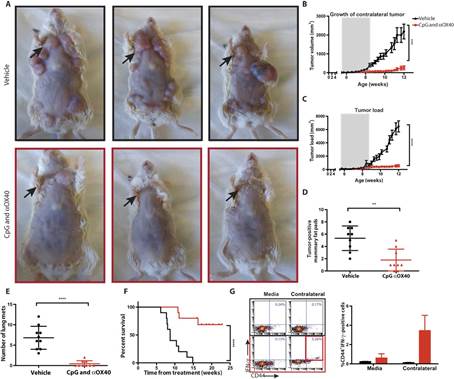仅注射一处肿瘤就能消除全身肿瘤的新疫苗
来源:《Science Translational Medicine》
作者:Idit Sagiv-Barfi等
时间:2018-03-26

人体的免疫细胞是纯天然的“肿瘤收割机”,但有时,这些细胞也会消极怠工,必须“踢”它们一脚,斯坦福大学的研究团队在小鼠身上验证,将一种免疫刺激混合物注入肿瘤可以激发免疫系统抗肿瘤效力。更重要的是,这种疫苗的效果并非局限于注射部位,还能消除体内其他部位肿瘤!
为了激起免疫系统对肿瘤的“愤怒”,研究人员已经尝试过各种分子和病毒。然而,到目前为止,这些候选物质没有一种能在人体内起效。斯坦福医学院的肿瘤学家Ron Levy团队用几种小鼠模型测试了20多种分子的抗癌能力,其中还包括几种能激活免疫细胞的抗体。
研究人员首先将癌细胞移植到小鼠腹部两处皮下组织来诱导肿瘤。当两处肿瘤都开始生长后,他们再将这些分子单独或组合注射到小鼠的其中一个肿瘤内,然后追踪小鼠们两处肿瘤反应。
效果最好的组合是一段名为CpG的DNA片段加上一个抗免疫细胞OX40蛋白的抗体。“单独注射这两种分子几乎没有任何效果,但是当它们协同作用时结果就不一样了。”注射后不到10天,直接接受注射治疗的肿瘤完全消失了,不到20天,另一个没接受注射的肿瘤也消失了!
两种分子激发了不同的免疫细胞,CpG DNA片段刺激树突状细胞,煽动免疫系统打响抗肿瘤反击战;OX40抗体作用于细胞免疫反应“士兵”T细胞,使这些细胞兴奋起来。
于是,Levy和同事又在一个乳腺癌品系小鼠身上测试了这一方法。同样地,如果小鼠发展出2个肿瘤,只要将混合物注入其中一个肿瘤,也会抑制第二个肿瘤的生长。不仅如此,该组合还能预防任何新乳腺肿瘤出现!
“它不仅能对抗多种癌症,还能破坏其他肿瘤,从而消除癌转移或癌症扩散引起的继发肿瘤,”Levy说。
马里兰Bloomberg-Kimmel癌症免疫疗法研究所的癌症免疫学专家Drew Pardoll评价:“太令人印象深刻了!尤其是这种疫苗对未注射肿瘤的效果。更值得称赞的是,研究人员还测试了‘自发发展的乳腺癌肿瘤’,这种小鼠模型更接近人类癌症发展实际情况。”
佛罗里达州Mayo诊所的免疫学家Keith Knutson在看过文章之后表示:“这项研究为‘免疫刺激疗法’进入人体临床研究提供了一个令人无法反驳的绝佳理由。”
目前,研究人员面对的最大的问题是这种方法是否也适用于人类,为此Levy和同事正在加紧进行临床试验,以评估其对淋巴癌患者的有效性和安全性。(来源:生物通 伍松)
Eradication of spontaneous malignancy by local immunotherapy
Abstract It has recently become apparent that the immune system can cure cancer. In some of these strategies, the antigen targets are preidentified and therapies are custom-made against these targets. In others, antibodies are used to remove the brakes of the immune system, allowing preexisting T cells to attack cancer cells. We have used another noncustomized approach called in situ vaccination. Immunoenhancing agents are injected locally into one site of tumor, thereby triggering a T cell immune response locally that then attacks cancer throughout the body. We have used a screening strategy in which the same syngeneic tumor is implanted at two separate sites in the body. One tumor is then injected with the test agents, and the resulting immune response is detected by the regression of the distant, untreated tumor. Using this assay, the combination of unmethylated CG–enriched oligodeoxynucleotide (CpG)—a Toll-like receptor 9 (TLR9) ligand—and anti-OX40 antibody provided the most impressive results. TLRs are components of the innate immune system that recognize molecular patterns on pathogens. Low doses of CpG injected into a tumor induce the expression of OX40 on CD4+ T cells in the microenvironment in mouse or human tumors. An agonistic anti-OX40 antibody can then trigger a T cell immune response, which is specific to the antigens of the injected tumor. Remarkably, this combination of a TLR ligand and an anti-OX40 antibody can cure multiple types of cancer and prevent spontaneous genetically driven cancers.
原文链接:http://stm.sciencemag.org/content/scitransmed/10/426/eaan4488.full.pdf




